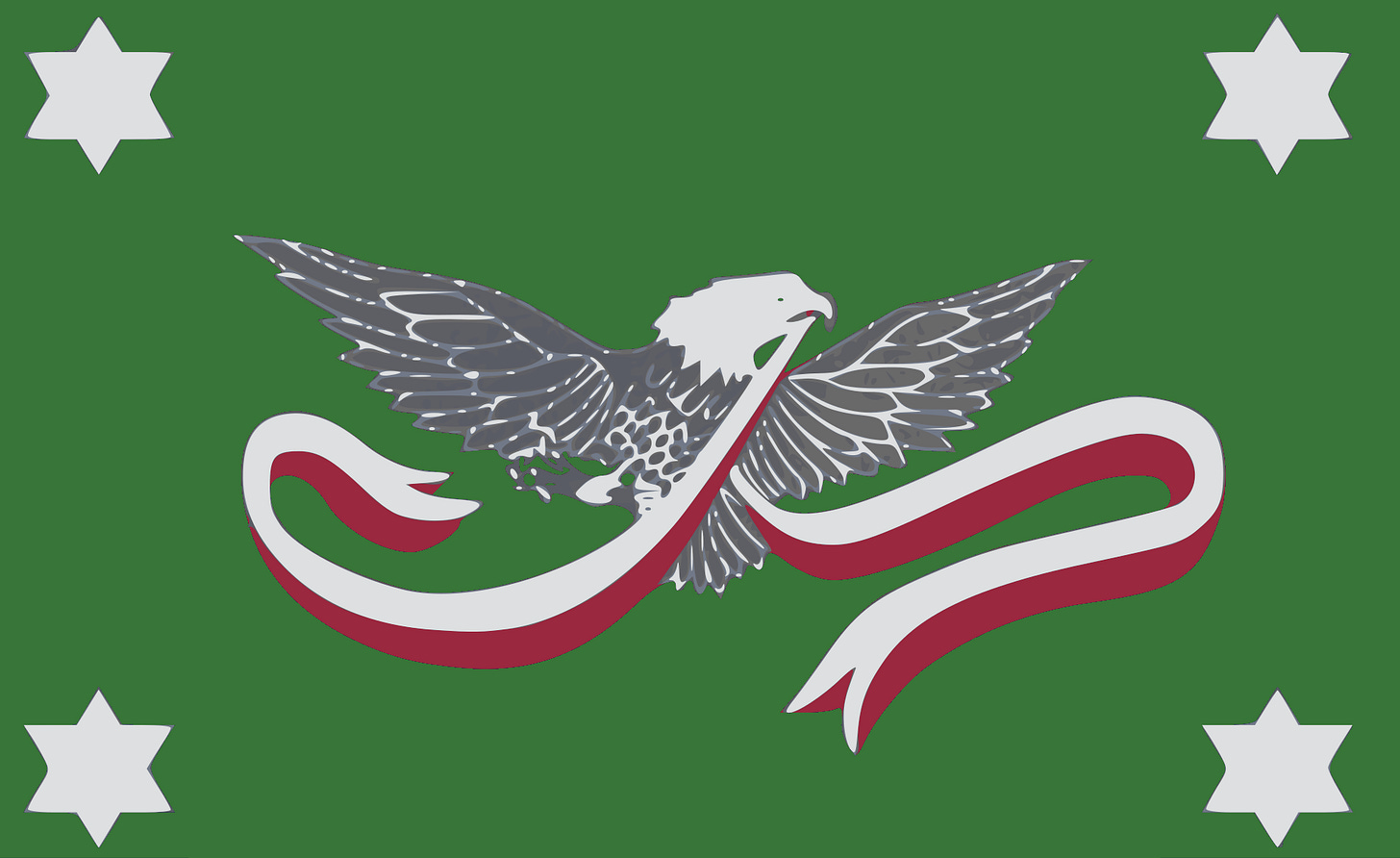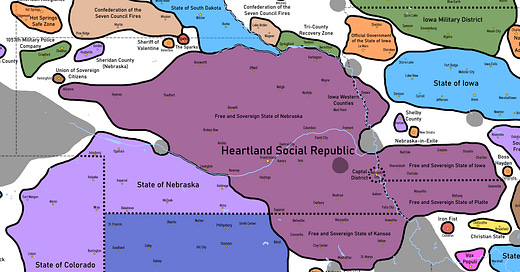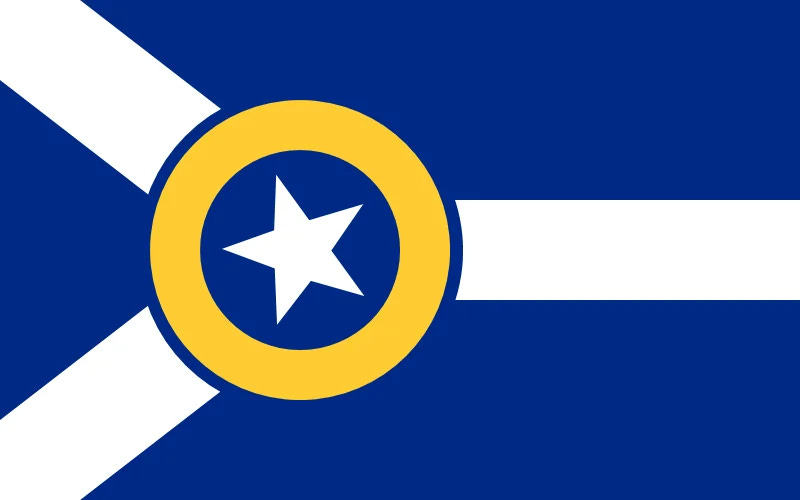The Fallen Continent: Nebraska
Two of America's mightiest factions vie for control over the Cornhusker State.
Population: 420,000
Largest City: Nebraska City
When it's sunny June and December too
Or in the wintertime or spring:
There'll be peace without end!
Every neighbor a friend!
With every man a king!
Introduction
Nebraska was set to be one of America’s most successful postwar states. It still is, but in a manner different from what its original leaders intended. Nebraska was targeted with relatively very few nuclear warheads. Omaha, Lincoln, North Platte, and a complex of missile silos in the southwest corner were all that were hit. With large stockpiles of corn and grain and a strong cattle industry, it seemed that most of Nebraska’s remaining population was going to survive the nuclear winter. Terrible mismanagement on the part of Nebraska’s surviving authorities, who were often working against each other, led to the fall of the state government and the rise of one of America’s most successful neo-feudal regimes.
Heartland Social Republic
Capital: Nebraska City
Classification: Special Case (Agrarian populist republic)

Capital District
Capital: Nebraska City
Allegiance: Heartland Social Republic
Free and Sovereign State of Nebraska
Capital: Grand Island
Allegiance: Heartland Social Republic
Brendan Wagner was a lawyer from Nebraska City. Everyone knew him from all the billboards he paid for around town, and his name recognition and legal skills helped him rise to the top of the local rationing board. This became an incredibly useful position when Nebraska City was swamped with hordes of refugees from Lincoln and Omaha. Using his position on the rationing board, he recruited fighters in exchange for food and conquered southeast Nebraska in the name of peace and security. Like any other neo-feudal warlord, he incorporated rival forces into his own, and allowed local authorities to continue operating as long as they pledged loyalty to him.
By the time Wagner put Nebraska City on the map, the rest of the state was at each other’s throats. Fremont had been seized by localist authorities, Norfolk was the domain of a renegade National Guard unit, Grand Island—the seat of the rightful state government—was busy putting out fires in all directions, Columbus hosted a rival self-proclaimed governor, McCook split off and elected its own new state government, and the northwest was no man’s land. The “Nebraska Pacification Army” didn’t seem like a likely candidate to conquer the rest of the state, but it did just that through Wagner’s good diplomacy and resourcefulness.
Any good neo-feudalist ruler, however, eventually realizes that unreformed neo-feudalism is not sustainable indefinitely and has to be replaced by a more permanent and meaningful order. Wagner found his answer in the Great Plains’ time-honored political tradition of “prairie populism.” He reorganized his government, reined in his soldiers, and forged an idiosyncratic ideology that he dubbed “the Heartland Theory,” but is often called “Wagnerism.” Tenets of Wagnerism include strong support for labor unions, a postal saving system as an alternative to banking, a wealth tax and wealth cap, and “the Imperial Presidency,” a theoretically democratic system in which “the perfect democracy looks a lot like a dictatorship.”
His new regime was called the Heartland Social Republic, and spanned most of Nebraska and parts of east Kansas, southwest Iowa, and much of Northwest Missouri at the time of his death. It has since expanded further in all directions, incorporating its conquests into “Free and Sovereign States” in a federal model. The HSR’s territory is internally divided along prewar state lines, although Nebraska City now belongs to the newly-minted Capital District, which spans both sides of the Missouri River. The rest of Nebraska became the Free and Sovereign State of Nebraska, with its capital in Grand Island.
After Brendan’s death his son, Nathan Wagner, inherited the Imperial Presidency in a landslide (and very much rigged) election. There is considerable debate regarding the future of the Republic. Some in Wagner’s government wish to steer the country down fascistic lines, while others want to pursue a leftist course and align with the ASFR in Wisconsin. Just as pressing of a question is what the Republic should do about Dodge City on their southern border. A confrontation seems inevitable, and only time will tell what fate has in store for the Heartland Social Republic.
The HSR also uses a unique form of representative currency, in which the Heartland Dollar is backed by the collective value of all government property. This includes public land, buildings, grain stockpiles, weapons and military materiel, and everything else, down to the office supplies of the lowliest government employees. The Heartland Dollar isn’t redeemable, but this practical basis has ensured more financial stability than most fiat currencies.
State of Nebraska
Capital: McCook
Classification: Local Government (Re-founded state government)
Allegiance: United States of America (Dodge City)
Isolated from the rest of the Nebraskan Anarchy, southwest Nebraska drew closer to Kansas and the federal authorities there. They closely followed the precepts of the Amarillo government during the Nuclear Winter and maintained unwavering support for Dodge City in the early days of the DC–Midland War. So strong was their support (and so hopeless was the situation in the rest of the state) that local authorities and a few state officials convened in McCook, where they proclaimed their own State of Nebraska.
Immediately following the 1st Dodge City Congress, the McCook government and the State of Oklahoma took part in the 2nd Dodge City Congress to join the Dodge City Convention and its United States government. The USA-DC subsequently recognized all other Nebraskan governments as illegitimate, including the rightful rump government in Grand Island. They reacted even more strongly to Wagner’s Heartland Social Republic, which remains an arch-enemy of the USA-DC. Despite their animosity, open conflict between the two juggernauts is limited to rare minor skirmishes along I-80 and the River Platte. Neither side wants an open war with the other unless some major upset comes along and potentially makes it worth the immense cost.
The McCook government regularly holds elections for local offices, statewide offices, and the truncated state legislature; they also partake in the USA-DC’s federal elections. Nebraska is the most Republican–dominated state in the Dodge City Convention; the only Democratic official in the entire state is the Mayor of McCook. In fact, the far-right Constitutional Patriot Party has a stronger presence in Nebraska than the Democrats, thanks to their successful campaign framing the HSR as socialist agitators.
Union of Sovereign Citizens
Capital: Hemingford
Classification: Right-wing Ideological Faction (Libertarian militia regime)
Just barely out of reach of the HSR, the town of Hemingford falls under the control of the Union of Sovereign Citizens. The Union is an idiosyncratic militia that claims to follow the unorthodox libertarian “Sovereign Citizen” movement. In theory, it is a self-defense unit of voluntary, free agents who are bound together by common interest and live under traditional English common law. In practice, the USC is not much different from the other right-wing militia regimes.
As militia factions go, they’re rather benign. They enforce their bizarre laws within their territory and keep to themselves. Most confrontations with the outer world are a result of cattle driving disputes on the open ranges of western Nebraska. The HSR has decided they’re not worth the trouble to attack, for the time being. Both they and Dodge City-affiliated governments to the north quietly agree that the USC serves as a convenient buffer between them.
1057th Military Police Company
Capital: Chadron
Classification: Military Faction (Military administration)
Allegiance: State of Nebraska, United States of America (Dodge City)
On the edge of the Badlands, northwest Nebraska fell victim to anarchy during the Nuclear Winter. Where the state government was absent, the 1057th Military Police Company (Capital: Chadron) rose to the challenge, recruiting civilians to bolster their numbers. The military remnants cooperated with Sheridan County to restore order to this corner of the state, successfully enduring the trials of the Starving Time.
Though the 1057th was not especially fond of the McCook government, they respected Sheridan County’s decision to remotely join it. They held off on joining themselves until McCook’s admission into the Dodge City Convention. The prospect of federal aid to stave off raiders from the Badlands was too valuable to let pass, so the Military Police followed McCook’s lead from then on.
The military regime’s status within the union is somewhat uneasy, however. Unlike Sheridan County, they do not hold elections and do not participate in any higher-level elections. They promise that civilian government will return to Chadron as soon as a contiguous connection with the rest of the Convention is established.
Sheridan County
Capital: Rushville
Classification: Local Government (County government)
Allegiance: State of Nebraska, United States of America (Dodge City)
Right next to the 1057th is Sheridan County, Nebraska (not to be confused with Sheridan County, Wyoming), a county regime that cooperated with the military police against raiders and warlords. The partnership between the two, combined with their remoteness, ensured their survival in the face of the Brendan Wagner’s empire. Though Sheridan did not take part in the original McCook convention, they did immediately petition to join as soon as word reached them of the government’s foundation.
They subsequently ended their state of emergency and held local elections, just before McCook itself joined the USA in Dodge City. Unlike the rest of the McCook state, politics in Sheridan County are nonpartisan. The most important office up for election is the County Sheriff, currently held by a popular independent candidate who ran on a pro-militia special interest platform.
Sheriff of Valentine
Capital: Valentine
Classification: Legitimist Warlord (Rogue law enforcement regime)
Far removed from the conflict of eastern Nebraska, the Sheriff of Valentine (really a code enforcement officer who launched a coup after the real Sheriff of Cherry County died) maintains control over the city through an alliance with the nearby Sparks gang and the Confederation of the Seven Council Fires. He knows the Indians are only using him as a buffer, but he’s willing to accept all the help he can get to resist HSR encroachment.
The Sparks
Capital: Sparks
Classification: Warlord (Vigilante gang)
The Sparks are a vigilante gang that rules their namesake town. Their founder was a charismatic used car salesman who was surprisingly much better at leading a militia than he was at selling cars. Most small-time warlord states, especially the ones that stay put in one town, fizzle out over the years, but the Sparks have stayed strong. Perhaps its due to their alliance with Valentine and the Sioux Indians, the indifference of the South Dakota state government, and their distance from Nebraska City. Whatever the case, they’re free from the HSR and proud of it.
Index
Click here to read the master post of the series, with links at the bottom of the page to all other Fallen Continent entries.
Previous Entry: South Dakota
Next Entry: Religious Movements











What happened to Seward?